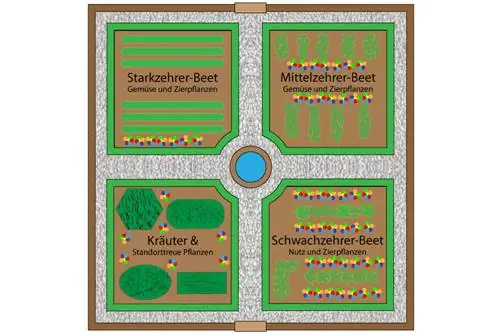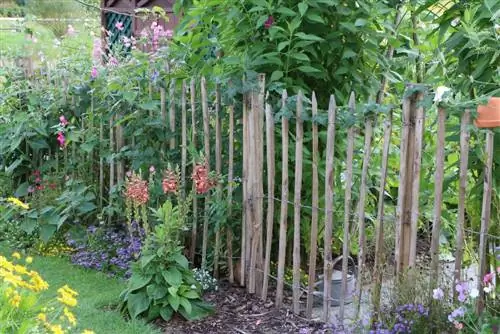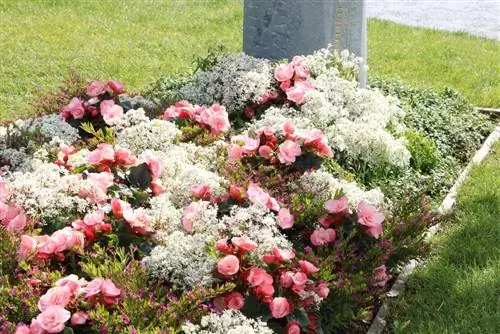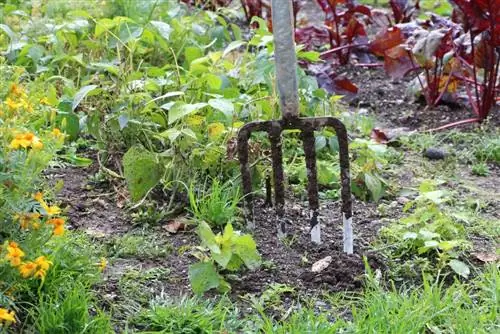- Author admin [email protected].
- Public 2023-12-17 03:39.
- Last modified 2025-06-01 06:48.
An authentic cottage garden is home to a colorful mix of ornamental and useful plants that offer both the eye and the palate a delightful experience. This historical garden style is only superficially a floral hodgepodge. In fact, the lush splendor of plants and flowers is based on a geometric layout that has endured for centuries. Plenty of scope for creative ideas allows for planting according to the gardener's individual preferences. The following planting plan would like to provide inspiration on the way to your unique and true-to-original farm garden.
Floor plan manifests true-to-original planting plan
So that the ideas for lush planting can bubble up and still end up with a credible cottage garden, the historical floor plan should remain unchanged. The concept goes back to the medieval monastery gardens, which consisted of an independent fruit, herb and vegetable garden, supplemented by the garden of the Great Cloister. Inventive farmers modified the expansive structure into a structure that unites all components. This arrangement still exists today and characterizes a true-to-original cottage garden:
- The basic structure is based on 4 square or rectangular beds of the same size
- A crossroads allows unhindered access to every bed
- Bedging separates the beds from each other
- The center is a roundel
- A fence with 1 to 2 entrances serves to delimit the area
The basic framework is complemented by decorative elements such as rustic fountains, romantic rose arches, nostalgic statues or inviting benches. Only natural materials are used, such as wood and stone. Any material of industrial origin, such as asph alt, plastic or aluminum, runs counter to the philosophy of an original cottage garden.
Tip:
So that the planting plan for your cottage garden results in lush growth and lavish flowers, the right location conditions are important. The location should be sunny to partially shaded, with nutrient-rich, humus-rich and fresh, moist soil. A pH value of around 7 with slight fluctuations in the slightly acidic to slightly alkaline range is ideal.
Planting plan is based on four-field farming
The planting of the 4 beds in the farm garden follows the guidelines of four-field farming. This concept aims to ensure a rich yield from your crops and a lavish display of flowers from your ornamental plants. A crop rotation is taken into account that takes into account the different nutrient requirements of the plants and flowers. As a result, heavy, medium and weak feeders are grown alternately. This strategy also deprives common diseases and pests of their livelihoods, which significantly improves plant resistance. Strictly speaking, the fourth bed remains fallow for a year and is only planted with green manure. In practice, home gardeners now plant native plants or berry bushes here. The fourth bed can also be used as a flowering herb garden.
Ideas for planting
The planting plan includes not only ornamental and useful plants for the 4 beds. There is also a selection of decorative border plants, pretty fence catchers for the fence and furious eye-catchers for the roundel in the center. Dive into a wide-ranging collection of ideas for the best plants and flowers for a romantic cottage garden with a nostalgic flair.
Suggestions for the heavy feeder bed
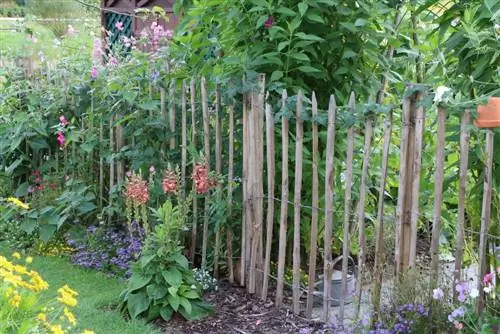
The labeling as a heavy eater essentially refers to a high need for nitrogen. Other main nutrients such as phosphorus and potassium as well as trace elements are also sufficiently important for vital growth for the following plants.
- Cauliflower (Brassica oleracea var. botrytis)
- Broccoli (Brassica oleracea)
- Brussels sprouts (Brassica oleracea var. gemmifera)
- Cucumis (Cucumis sativus)
- Pumpkin (Cucurbita)
- Tomatoes (Solanum lycopersicum)
- Potatoes (Solanum tuberosum)
Although some of these vegetable plants bloom beautifully, the following flowers also appear in the cottage garden:
- Foxglove (Digitalis)
- Dark spur (Consolida ajacis)
- Sunflower (Helianthus)
- Stuffed Bertram's Sheaf (Achillea ptarmica)
Where parts of the cottage garden are in partial shade, hostas with their magnificent foliage feel in good hands. Small hydrangea species, such as the plate hydrangea 'Koreana' Hydrangea serrata, which only grows to a height of 40 to 50 cm, provide romantic opulence. When choosing flowers, it is important to note that they do not permanently shade the vegetable plants. Imposing flowering trees with a height of more than 100 cm therefore take up space on the outer edge of the plant.
Suggestions for the Mittelzehrer bed
The Mittelzehrer bed contains a variety of very he althy vegetable plants that provide variety on the menu. The following selection shows what a wide range of suitable species and varieties enriches the planting plan for a typical cottage garden:
- Carrots (Daucus)
- Fennel ((Foeniculum vulgare)
- Beetroot (Beta vulgaris subsp. vulgaris var. conditiva)
- Chinese cabbage (Brassica rapa subsp. pekinensis)
- Spinach (Spinacia oleracea)
Of course, all kinds of salads are a must here. Lettuce (Lactuca sativa) is also included, as is radicchio (Cichorium intybus var. foliosum) or endive (Cichorium endivia). The vitamin-rich palette is complemented with decorative flowers that create an eye-catching neighborhood with the crops.
- Common Columbine (Aquilegia vulgaris)
- Peony (Paeonia)
- Bergenia (Bergenia cordifolia)
- Purple bells (Heuchera)
- Shrub and floribunda roses (pink)
Floral beauties such as marigolds (Calendula) and marigolds (Tagetes) also fulfill the helpful task of driving away nematodes and other pests from the bed. Rough-leaf asters (Aster novae-angliae), smooth-leaf asters (Aster novi-belgii) or the majestic elf rue (Artemisia lactiflora), which harmonize wonderfully with shrub roses, provide autumnal colors.
Tip:
In each of the four Bauergarten beds, annual summer flowers bring variety to the appearance. Sown in good time in spring, cosmidia (Cosmidium burridgeanum), zinnias (Zinnia elegans) or girl's eyes (Coreopsis) last well into autumn.
Plants and flowers in the Schwachzehrer bed
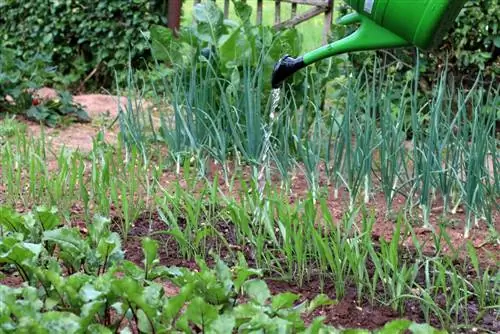
The following cottage garden plants make do in the low-feeder bed with the nutrients left by heavy and medium-feeders.
- Lentils (Lens culinaris)
- Peas (Pisum sativum)
- Radish (Raphanus sativus var. sativus)
- Faba bean (Vicia faba)
- Lamb lettuce (Valerianella)
- Purslane (Portulaca oleracea)
Frugal ornamental grasses and flowers round off the imaginative planting plan at this point. We would like to recommend the following plant species to you:
- Goose cress (Arabis caucasica)
- Pansies (Viola)
- Carnations (Armeria maritima)
- Heart quaking grass (Briza media)
- Gold-edged sedge (Carex dolichostachya)
Bulb and bulb flowers are useful as pretty eye-catchers in each of the beds. Snowdrops (Galanthus), Marchbreakers (Leucojum vernum) and crocuses (Crocus), for example, are responsible for a flower-rich start to the garden year. In summer, lilies (Lilium x cultorum), Montbretia (Crocosmia x crocosmiiflora) and imperial crowns (Fritillaria imperialis) boast their flowers. Autumn is beautified by autumn crocus (Colchicum autumnale) or saffron (Crocus sativus).
Options for the fourth bed
Strictly speaking, the fourth bed receives green manure so that the soil regenerates before it reopens the plant chain with the heavy feeders. Since the focus in cottage gardens is increasingly on ornamental value, the planting plan at this point uses the following options:
- Rhubarb (Rheus)
- Strawberries (Fragaria)
- Asparagus (Asparagus)
- Wild garlic (Allium ursinum)
- Parsley (Petroselinum crispum)
The fourth bed is also a good place to plant symbolic cottage garden flowers. The following flowers were already an indispensable part of the planting plan in the Middle Ages to decorate the altar on Assumption Day and other church holidays:
- Madonna Lily (Lilium candidum)
- Lady grass (Hierochloe odorata)
- Marie flower, daisy (Bellis perennis)
- Milk thistle (Hierochloe odorata)
As a medicinal and ornamental plant with a long tradition, the chicory (Cichorium intybus) should not be ignored here, just like the wild strawberry (Fragaria vesca), which already provided juicy, sweet moments of happiness in the 16th century, straight from the farm garden.
Planting ideas for the bed border

The Buxus has had its day as a border plant in the cottage garden. The high susceptibility to diseases and pests, such as the boxwood borer, has catapulted the evergreen ornamental tree out of the planting plan. However, you don't have to do without a decorative frame for the four beds. The following plant species are much more than a simple boxwood substitute:
- Box-leaved barberry (Berberis buxifolia)
- Dwarf privet (Ligustrum vulgare)
- Mountain Ilex (Ilex crenata)
- Lavender (Lavender officinalis)
- Dwarf strawflower strawflower (Helichrysum italicum)
It doesn't necessarily have to be shrubs or sub-shrubs that surround a cottage garden bed. Flowering and fragrant perennials fulfill this task just as impressively. These include, among others, purple chives (Allium schoenoprasum), cushion phox (Phlox subulata or douglasii), blue cushions (Aubrieta) or carnations (Armeria maritima).
Berry bushes frame the area
If there is enough space available for a cottage garden, the floor plan is expanded with a free area of 60 to 100 cm wide between the fence and the beds. The following berry bushes find a permanent location here:
- Gooseberries (Ribes uva-crispa)
- Raspberries (Rubus idaeus)
- Blackberries (Rubus fruticosus)
- Blueberries (Vaccinium myrtillus)
By planting red, white and black currants alternately here, you can add brilliant color accents when the bushes present their fruity berry display. Black elderberry (Sambucus nigra) is essential for the typical cottage garden. Charlemagne included the mighty berry bush in the legendary Capitulare de villis plant list for the cottage garden in the 9th century.
Tips for decorative fence peepers
To create the enclosure, traditional home gardeners like to opt for a picket or hunter fence. Braided willow fences are also very popular for enclosing a cottage garden in style. With a greenery of flowering fence peepers you can give the sober borders a romantic nuance. The following plants have particularly stood out in this regard:
- Dahlias (Dahlia)
- Storksbill (Geranium)
- Clematis
- Hollyhocks (Alcea)
A wild perennial with strong growth and golden-yellow ray flowers has given a cottage garden fence a decorative appearance for generations. Real elecampane (Inula helenium) is not only beautiful to look at, but also ensures numerous offspring through diligent seeding without any intervention on your part. Annual climbers are perfect for decorating a fence with a different display of flowers every year. The delicate perennial vetch (Lathyrus latifolius) is a shining example, or the enchanting bush mallow (Lavatera).
Picturesque climbing plants

When flower-filled trellises mark the entrance or rise above a bench, your cottage garden invites you to linger. We have looked around the most beautiful cottage gardens and put together the following ideas for picturesque planting with climbing plants:
- Honeysuckle (Lonicera heckrottii)
- Red-leaved vine (Vitis vinifera)
- Black-eyed Susan - annual - (Thunbergia alata)
- Morning glory - annual - (Ipomoea)
- Mandevilla - annual - (Dipladenia)
In semi-shady to shady locations, the climbing hydrangea (Hydrangea petiolaris) transforms every climbing aid into a sea of flowers. In contrast, the climbing trumpet (Campsis radicans) likes it sunny and warm. If a stable planting arch is available, wisteria (Wisteria floribunda) becomes the center of interest in a warm and protected location. The finger-leaved climbing cucumber (Akebia quinata) is not one of the classics for the cottage garden. It makes up for this fact with pretty flowers in May, a magnificent dress of leaves and edible fruits in autumn.
Tip:
You can visually enhance your cottage garden with clever decorative elements. At flea markets, look for old vessels such as a zinc tub, hand-woven baskets or a nostalgic wheelbarrow. Equipped with small holes for water drainage, you can plant flowers, colorful sempervivum or flowering herbs here.
Historic herbal plants
In order to alleviate he alth problems or to give bland dishes more flavor, the classic planting plan for the cottage garden has incorporated the following herb and spice plants for centuries:
- Arnica (Arnica montana)
- Eyebright (Euphrasia officinalis)
- Valerian (Valeriana officinale)
- Coltsfoot (Tussilago farfara)
- Lungwort (Pulmonaria officinalis)
With the conquest of Germania by the Romans, Mediterranean herb species came into the cottage garden and are still very popular today. Basil, thyme, oregano and rosemary still enhance the culinary enjoyment of hot and cold dishes with their special aroma.
No cottage garden without roses
The queen of flowers has ennobled the cottage garden for generations. As bedding and shrub roses, their most magnificent varieties cavort in the middle of the beds. As a climbing rose, it gives the fence or a climbing arch a stately appearance. In order to preserve the traditional character of the garden, modern rose varieties are left out. Rather, the focus is on the following historical roses, as they found their way from the medieval gardens of monasteries and nobles to the gardens of farmers:
Alba roses
Alba roses are among the oldest cottage garden roses. In contrast to modern varieties, they only bloom once a year, but in abundance and with huge, fragrant flowers. Since they grow bushy, with an upright and slightly overhanging posture, they are perfect for showcasing themselves in a roundabout. The 'Semiplena' variety has been delighting people with its white, semi-double cup flowers and seductive scent since the 14th century. Since 1759, 'Celeste' has impressed with uncomplicated care, reliable winter hardiness and delicate pink, semi-double flowers.
Centifoils
When these lush double roses were successfully bred in Holland at the end of the 16th century, they quickly established themselves as typical cottage garden roses. They have retained this status to this day. Although they thrive primarily upright, they also like to lean against the fence of the enclosure. The variety 'Reine des centifeulles' impresses with densely double flowers in deep pink. The popular variety 'Vierge de Cléry' provides bright white flowers.
Noisetterroses
At the beginning of the 19th century, the strong-growing Noisette climbing roses set out to decorate the cottage garden. The delicate flowers gather in small clusters, creating a particularly opulent image. The premium variety 'Mme Alfred Carrière' thrives almost without thorns and boasts white, double, fragrant flowers until the first frost. The historical beauty 'Céline Forestier' comes with an elegant color nuance in delicate light yellow. Since it lacks the spines to aid climbing, a noisette rose is simply tied to the rose arch.
Conclusion
The atmospheric atmosphere in the cottage garden is based on a creative composition of plants and flowers, which is based on a historically handed down floor plan. This collection of planting ideas aims to stimulate your imagination to create an individual and authentic planting plan from an exuberant variety of species. The weighting according to useful and ornamental plants is your personal decision, as long as the basic structure of 4 beds, a crossroads and a fence is preserved.

